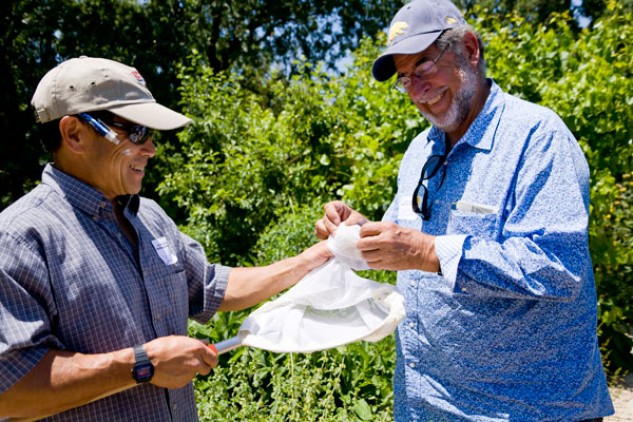
Dr. Gordon Frankie and a volunteer collect their findings at the Sonoma Bee Count, a local citizen science project.
In honor of National Pollinator Week, Bay Nature's Beth Slatkin recently interviewed Professor Gordon Frankie on the status of California's diverse and productive pollinators. Read an excerpt of the interview here, and check out the full article on the Bay Nature site.
For those not familiar with native bees, how many species are there?
We have about 1,600 species in California, 4,000 in the US, and 20,000 worldwide. Of the 20,000 species worldwide, only two - the European honey bee and the bumblebee - live in hives.
How are California bees faring this year?
Our gardens here in Northern California are seeing an average amount of activity, but overall the numbers are down, especially in the southern part of the state. It has a lot to do with the drought, which affects the plants and then the bees: It’s caused delays in the bees’ emergence from their nests and burrows. Some native bees aren’t emerging at all.
Can the bees hold out, waiting for a good year?
Some of these bees are amazing; they can hold over for years until they come out. We’ve had droughts before and we’ll have them again, and the bees know what to do. It’s the third year of the drought, and they have the capacity to hold out for another year.
One of your main projects is the California Native Bee survey, which you’ve been conducting for the past ten years in 15 cities throughout California. What have you learned?
Our main finding is that our native bees have preferences, and they sort themselves out according to what kinds of plants they prefer. We’ve determined this through hours and hours of visitation counts at host plants – we’ve done something like 7,000 counts at 3 minutes apiece at the 50 gardens we visit each year.
And you can predict where the bees will be?
Yes. People ask us, “How did you know these were going to be here?” We know because the bees repeat themselves. We know that if you have the native perennial herb Lotus scoparius, for example, it’s going to attract Anthidium and Osmia (mason bees). And if you have Wisteria, it’s going attract the large carpenter bees. Sunflowers are good for the little sweat bees and Melissodes (the longhorn bees).
A big part of your research involves introducing California farmers to the benefits of native bees. Tell us a bit about your work on this front.
We’re working with eight farmers in Brentwood (Contra Costa County) and four farmers in Ventura County—mostly avocado farmers—to demonstrate how native bees can play a part in the food crop pollination process, and hopefully supplement our honeybees with their services. We’ve divided the farms into “treatment” sites where we add bee-attracting plants, and “control” sites where we just monitor bee activity and do nothing more, and compare the results. Every farm is different in how they do things, so these partnerships avoid a “one-size-fits-all” approach.
You claim native bees will be able to do a lot of the work honeybees are no longer doing. Is this a reasonable expectation?
Yes! We have one of the richest bee-flower faunas in the world. We have 5,000 species of flowering plants in California — 6,000 if you count subspecies, varieties, and hybrids — and the vast majority are pollinated by native bees because they evolved with them. If we have enough time and enough good people cooperating, we’ll have very good pollination by native bees in the future. For example, in Brentwood we work with a conventional farm that even sprays herbicides at least once a year, but we’ve already recorded 64 species of bees on this one farm, which is really amazing.
What kinds of challenges have you encountered introducing native bees to farms?
The big problem is, will people give you enough space to create bee habitat? We started out really slow; the farmers were hesitant because they were afraid of lowered productivity. So far, we haven’t taken away any productivity.
How are you dealing with their fears?
We’re working on the edges of the farms, planting cover crops and ornamentals. They’ve been pretty good to us; every time we go out there they’re willing to give us a little bit more land they’re not using, or land that will take time for trees to grow to maturity. In the latter case, we use native annuals for a period of 3-4 years; we’re also just starting to use them for cover crops between rows of orchard trees.
Read the rest of the interview on the Bay Nature website.
Interview by Beth Slatkin, marketing and outreach director for Bay Nature.
